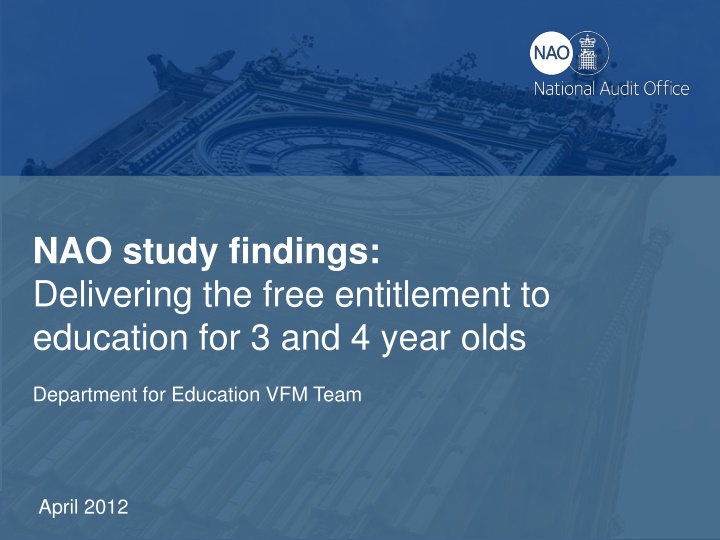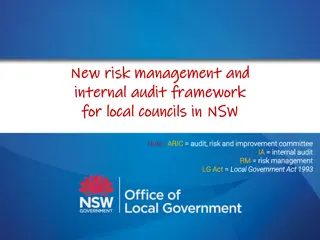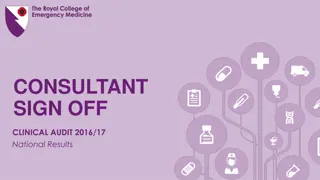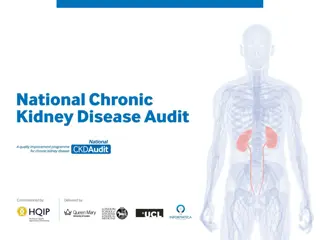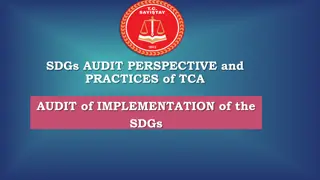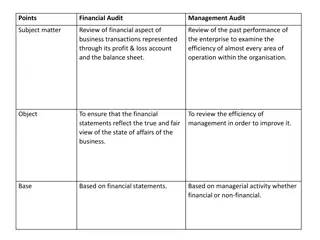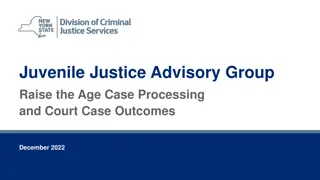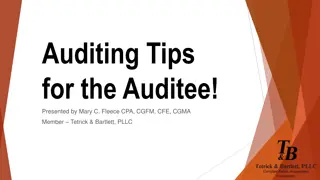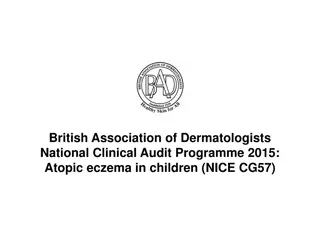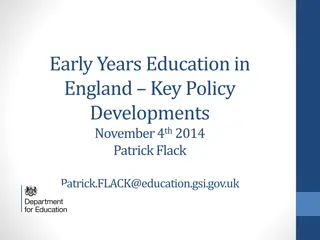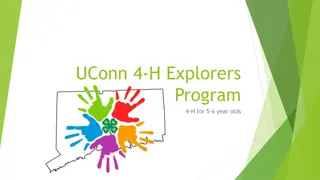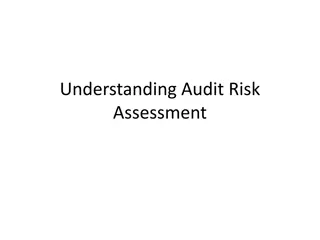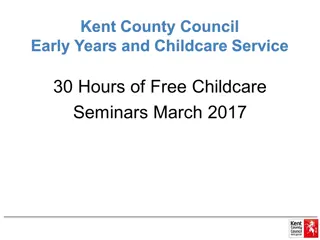National Audit Office Report on Free Education Entitlement for 3 and 4 Year Olds
The National Audit Office conducted a study on delivering the free entitlement to education for 3 and 4-year-olds in April 2012. Their role is to provide independent information, assurance, and advice to Parliament on the use of public resources to promote better financial management and value for money. The accountability process involves audits, spending examinations, and reporting to Parliament, with a focus on achieving value for money. The methodology included interviews, policy document reviews, census analysis, and data evaluation. Key facts and figures on spending, enrollment, and quality ratings were presented.
Download Presentation

Please find below an Image/Link to download the presentation.
The content on the website is provided AS IS for your information and personal use only. It may not be sold, licensed, or shared on other websites without obtaining consent from the author.If you encounter any issues during the download, it is possible that the publisher has removed the file from their server.
You are allowed to download the files provided on this website for personal or commercial use, subject to the condition that they are used lawfully. All files are the property of their respective owners.
The content on the website is provided AS IS for your information and personal use only. It may not be sold, licensed, or shared on other websites without obtaining consent from the author.
E N D
Presentation Transcript
NAO study findings: Delivering the free entitlement to education for 3 and 4 year olds Department for Education VFM Team April 2012 Helping the nation spend wisely
What is the National Audit Office? Our role: To provide independent information, assurance and advice to Parliament on the use of public resources To help promote better financial management and value for money Our aim: We apply the unique perspective of public audit to help Parliament and government drive lasting improvement in public services. Helping the nation spend wisely
The accountability process Government requests and Parliament grant funds C&AG audits accounts, examines spending and reports to Parliament Government response PAC session and report Helping the nation spend wisely
Value for money audit (VFM) Good VFM is the optimal use of resources to achieve the intended outcome Our reports are used by Parliament to hold government to account for how it spends public money Our reports highlight important lessons for the body we audit and for government more widely We don t comment on the merits of policy but aim to conclude on whether value for money has been secured Helping the nation spend wisely
Our methodology The Department s role: funding, oversight and management of the delivery system The free entitlement only not reception classes or the wider early years market inspected by Ofsted Key methods: Interviews with the Department, local authorities and other stakeholders Review of policy documents and academic literature Census of local authorities Analysis of data held by the Department and Ofsted Helping the nation spend wisely
Key facts and figures 1.9bn 831,800 452m 28,630 78% 3.95 3.5% - 9.8% 152 59% Forecast estimate of spending by local authorities on provision of the free entitlement in 2011-12 (up from 1.6bn in 2010-11) Number of 3 and 4 year olds estimated as receiving the free entitlement in January 2011 Hours of free entitlement funded in 2011 (up from 276m in 2003) Number of provider settings offering the free entitlement Providers rated good or outstanding by Ofsted in between September 2008 and March 2011 Average rate of local authority funding per entitlement hour in 2010- 11 Range in the proportion of Dedicated Schools Grant spent on the free entitlement by local authorities in 2010-11 Funding formulae (each local authority has its own formula) Proportion of children who achieved a good level of development at age 5 in 2011 Helping the nation spend wisely
How did we assess value for money? Whether the Department is achieving value for money in delivering the free entitlement We assessed whether: The Department is achieving its objectives for the entitlement The Department s funding arrangements support its overall objectives The Department uses information to understand and improve value for money Helping the nation spend wisely
Achieving objectives High national take-up rate for early education but lower for disadvantaged children Children s development at age five has improved, but results at age seven have not Quality of providers offering the entitlement sustained since 2008-09 Take-up of the entitlement and access to high quality provision varies depending on where children live Helping the nation spend wisely
Quality and area deprivation % of providers rated good or outstanding by Ofsted (2008-2011) 100.0 90.0 80.0 83.9 81.9 80.6 79.7 78.0 77.6 76.5 75.7 74.5 70.0 73.3 60.0 50.0 40.0 30.0 20.0 10.0 0.0 1 (Low deprivation) 2 3 4 5 6 7 8 9 10 (High deprivation) Level of deprivation Helping the nation spend wisely
Funding arrangements Local authorities direct different proportions of national funding to the entitlement and funding formulae for local distribution vary significantly Funding arrangements provide limited incentives for providers to improve quality Many providers claim that funding does not cover costs of delivering the entitlement. At least a third of funding formulae are based on limited understanding of provider costs Helping the nation spend wisely
Variations in local authority funding (1) EYSFF within DSG Base rates within EYSFF % of EYSFF spent on base rates in 2010-11 % of DSG spent through EYSFF in 2010-11 Source: NAO analysis of local authority data Helping the nation spend wisely
Variations in local authority funding (2) Number of base rates - pathfinders Source: NAO analysis of local authority data Helping the nation spend wisely
Using information to drive value for money The Department does not yet have robust measures to demonstrate whether longer-term benefits are being realised Before 2010-11, the Department did not have sufficient data to estimate total spending on the free entitlement The Department has not tracked what drives performance across providers or authorities The Department lacks analysis of the relationship between performance and funding levels. Parental choice drives the market for the entitlement but there are limitations in the information available to parents Helping the nation spend wisely
Relationship between funding and quality Helping the nation spend wisely
Conclusion and recommendations In delivering the free entitlement to early education, the Department and its partners have made progress against many objectives: the entitlement has been extended overall take-up levels have been sustained children s development as measured at age five has improved. Recommendations However: a longer-term impact on attainment is not yet visible the Department and its partners do not yet sufficiently understand the relationship between local performance and funding if it is to achieve value for money and ensure the best return for its investment of 1.9 billion, the Department needs to address variations in: take-up, access to high-quality provision and the impact on attainment in later years Use existing information to identify what drives successful performance Analyse overall performance of local authorities over time, including impact of 90% baseline funding Identify key data to support local authority benchmarking Enhance information available to parents Review information needed to support local authorities to manage their local markets Simplify local funding formula arrangements Develop evidence base on long term benefits Develop measures to judge the return on investment Helping the nation spend wisely
Market principles Market principles Issues raised in NAO report Department sets the overall funding and delivery framework Local authorities administer funding and delivery arrangements Ofsted enforces delivery of EYFS curriculum Are there rules to ensure effective operation of the market? Funding decisions are determined by parents choice of provision Parents choices driven by factors such as convenience, general well-being of children and cost of additional hours Limitations in the information available to parents Are users able to make informed choices? Local authorities direct different levels of national funding to the entitlement (between 3.5 and 9.8% of DSG allocation) 58% of day nurseries report that funding does not cover the costs of provision (Laing & Buisson) 72% of local authorities estimate that the funding they offer is sufficient to cover costs for all or most providers Does the market promote healthy competition? No robust measures to demonstrate the achievement of long-term objectives Poor quality data limits analysis of variations in performance No robust departmental analysis of the relationship between performance and funding levels Some analysis carried out by local authorities but this is not widespread Is the market delivering the public policy objectives? Helping the nation spend wisely
Current use of information by local authorities Comparisons of performance Analysis of EYFSP results Source: NAO survey of local authorities Helping the nation spend wisely
Questions? Helping the nation spend wisely
